Choosing a hosting control panel

The hosting control panel is a software tool that allows you to manage a web server and the sites hosted on it through a graphical interface. Using the control panel, you can perform such operations as managing mail services, FTP accounts, databases, adding and deleting domains and subdomains, downloading files, viewing traffic statistics, setting up pre-installed scripts and others.
As a separate product, hosting control panels became widely used in the late 1990s. Since then, they have greatly changed and improved. Today, there are a huge number of hosting management solutions on the market - both free and proprietary. How to choose a really worthy product from all this variety?
')
On the Internet, you can find publications that compare the available panels (for example, good translation material ; see also here ). We decided to create our own review, in which the emphasis is placed slightly differently than in the previously published ones. One of the main criteria underlying our review is the panel support for web servers and their combinations. In addition, in our article we consider the products that are not included in the publications by the links above.
ISP Manager
Developer : ISP System
First version : 1997
Latest version : 5.17.4 (July 2014)
Supported OS : Linux, Free BSD, Windows
License : proprietary
Official site : http://ispsystem.com
To install ISP Manager, it is enough to download a special script from the official site from the console and launch it, and after launching, specify the required version (4 or 5) and edition (Lite or Pro). In version 4, installation is performed via the console, and in version 5, it is different: when you select the minimum option, a link is displayed on the console that you need to open in the browser and continue the installation by selecting the necessary components. Note that, unlike the fourth, the fifth version has a modular structure: only the Core component is required. On its basis, it is already possible to select other components used - for example, ISP Manager Pro or Lite (there are other components that will not be considered in this article). However, when you select the recommended installation option in the console, all the necessary components will be installed automatically.
The default is an Apache web server. Nginx is installed additionally (for this you just need to go to the section "Server Configuration" -> "Features"):
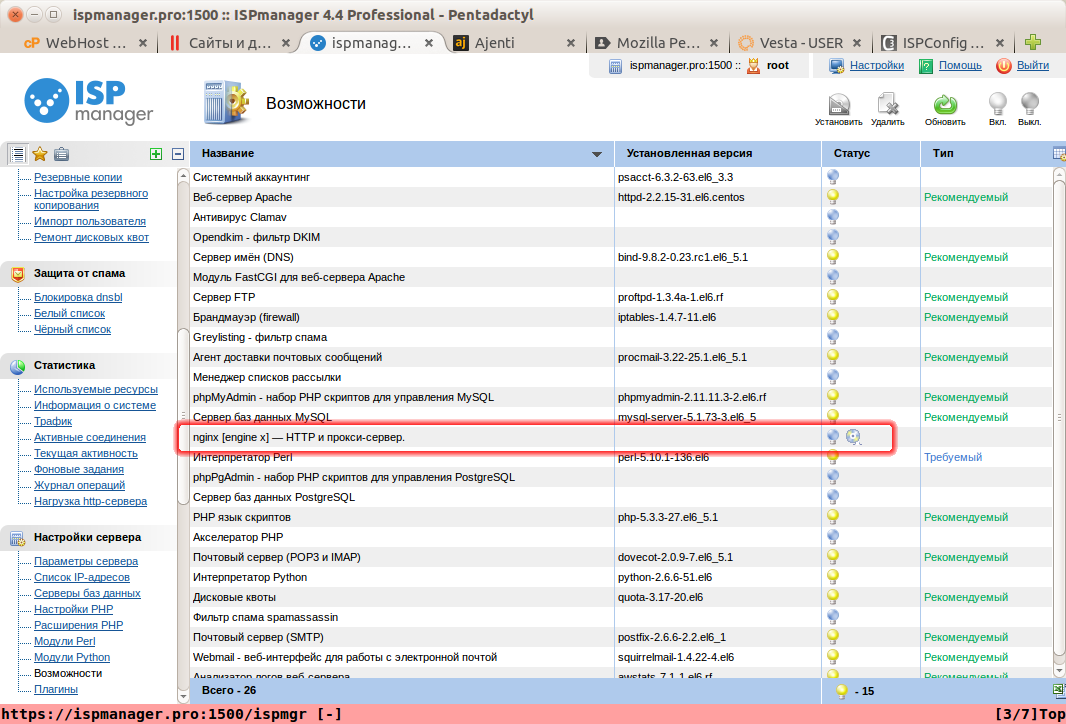
After installation, it automatically becomes a frontend, and Apache becomes a backend. This is done in order to divide the various functions between Nginx and Apache: Nginx copes very well with supporting multiple sessions and sharing static content (pictures, music, video, etc.), Apache has extensive capabilities for supporting dynamic data.
After that, Apache will start listening on port 81 (in the fifth version, on 8080), which makes it possible to access it directly, without using Nginx. To do this, you just need to specify the port in the browser address bar, for example, example.com : 81 /.
For security reasons, after installing Nginx, it is advisable to use iptables to block access to the server on port 81, leaving only the local (127.0.0.1) and external IP address of the server as allowed. This can be done in the panel itself through a graphical interface in the firewall section:
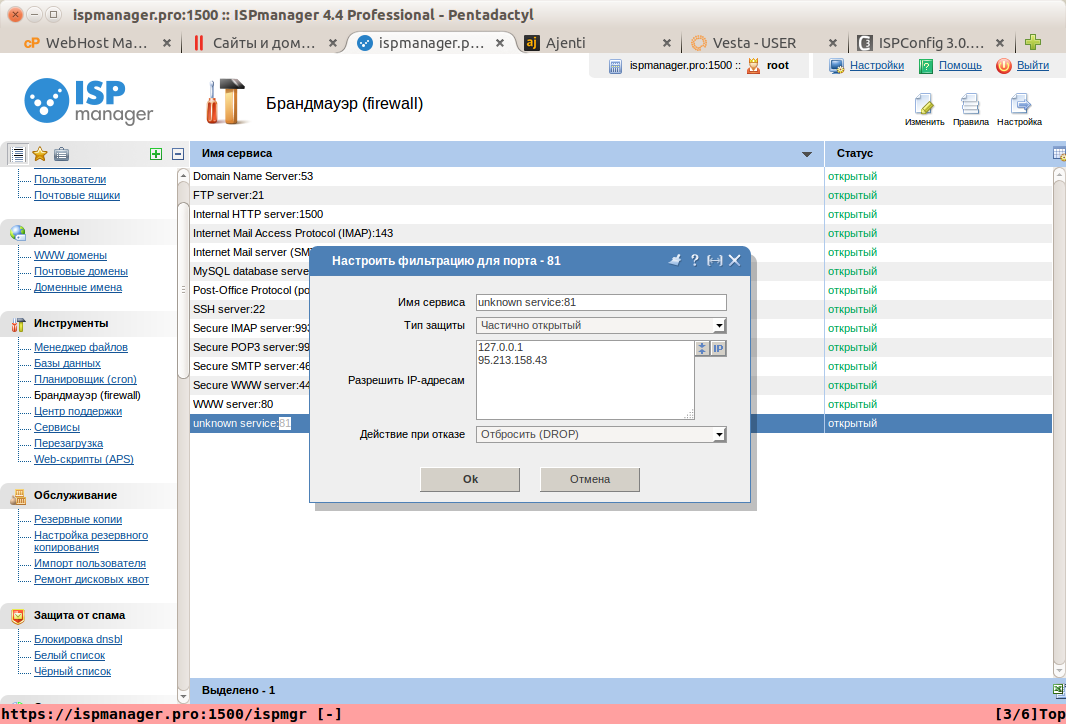
In this case, some users prefer to change the address for apache to local (127.0.0.1), leaving port 80. It is not recommended to change the system settings that can be returned to the standard in case of any updates of the control panel.
Unlike version 4, version 5 uses an independent web server that provides the control panel and is not related to either Apache or Nginx. That is why you can stop using Apache. It is only necessary to configure the site to work in conjunction Nginx + php-fpm. It is necessary, however, to take into account that php-fpm cannot completely replace apache. For example, when switching to php-fpm, the URL-to-personable conversion function (implemented via mod_rewrite to Apache) should be processed by the Nginx web server.
The advantages of the fifth version include the ability to directly edit the Apache and Nginx configuration files for the selected domain, so that for each domain you can set individual settings that will not apply to the rest.
Also undoubted advantages include support for web scripts in APS format, with which you can install ready-made CMS for the selected domain in semi-automatic mode. From the user, you only need to select the desired application from the list and specify the necessary parameters for it (created database, user, password, etc.).
Among other advantages of ISP Manager, you should also mention the presence of a wide range of functions for managing the server, ease of transferring accounts between hosts, a convenient multilingual interface, and detailed and understandable documentation.
The disadvantages include the limited firewall management functions and its default inactivity. Although the firewall control module is activated at the panel installation stage, by default the rules are inactive. To activate them, you must make at least one change to the list of existing rules from the control panel (for example, as indicated above).
Plesk panel
Developer : SWSoft , now distributed by Parallels
First version : 2003
Latest version : 12.0.18 u4 (July 2014)
Supported OS : Centos, OpenSUSE, CloudLinux, RHEL, Debian, Ubuntu, Windows
License : proprietary
Official site : http://sp.parallels.com/ru/products/plesk/
To install Plesk Panel, simply download the installation script from the official website and run it from the console.
"Out of the box" is supported by a bunch of Nginx + Apache, no additional configuration is required. You can immediately create a domain and download the contents of the site. If, after installing the panel, an additional firewall module is also installed, then the rules restricting access to the Apache web server will be immediately applied.
Working in Nginx + php-fpm mode is possible, but for this you need to install the php-fpm support component from the Parallels installation and update page:

and indicate for the selected domain that php files should be processed using Nginx:

Like the ISP Manager, Plesk Panel allows you to install the necessary web applications (APS) from the control panel itself, thereby reducing the user's actions to prepare the site to a minimum.

The advantages of Plesk are the user-friendly interface, a rich set of functions, the presence of numerous extensions (addons) installed directly from the control panel.
There is only one drawback: the overload with modules that most end users are unlikely to need.
Ajenti
Developer : Evgeny Pankov
First version : 2010
Latest version : 1.2.20 (April 2014)
Supported OS : Debian 6.0 and above, Ubuntu 10.04 and above, CentOS 6.0, RHEL, FreeBSD, ArchLinux, Gentoo
License : GNU LGPL
Official site : http://ajenti.org/
Ajenti is an environment for performing administrative tasks on a server through a web interface. Website maintenance and management is carried out using the Ajenti-V add-on, which also allows you to manage the Nginx web server.
To install Ajenti, just download the script from the official site and run it. The required repository will be automatically connected; all necessary packages will be installed from it. Ajenti-V packages need to be installed separately:
# apt-get install ajenti-v ajenti-v-nginx ajenti-v-mysql ajenti-v-php-fpm # service ajenti restart
By default, Ajenti-v is designed to work with the Nginx web server in conjunction with php-fpm, wsgi, puma, unicorn, node.js. Apache is supported, but this support is minimal: the user gets only access to the configuration file, which is responsible for the work of the selected domain:
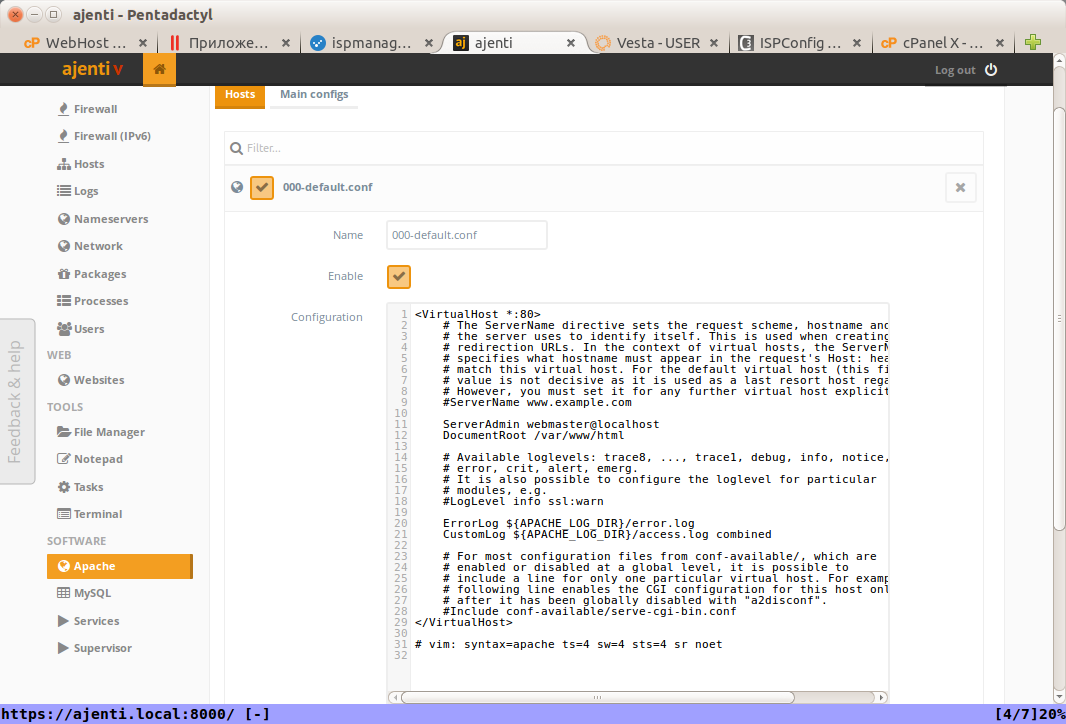
Nginx in this case must be configured to work as a reverse proxy:

Users with no direct experience editing configuration files may have problems at this stage. The web interface, through which Nginx parameters are edited, may seem unusual, and it’s most likely that it’s impossible to set everything up correctly the first time: you will need to edit the settings several times from the web interface, and then view the files generated by Ajenti-v and compare the results. with conceived.
The interface for configuring embedded interpreters (for example, php-fpm or uwsgi) is better structured, but even here it is likely to encounter various kinds of surprises. But after the first acquaintance, experienced users will be able to appreciate this minimalistic approach and its convenience.
Among the advantages of Ajenti, let's call a large set of functions for managing web servers and sites, which can be expanded with the help of additional modules and plug-ins. The panel has a convenient web interface, implemented on AJAX. Ajenti is a generally comfortable environment, not overloaded with settings and settings, so that even a beginner user can easily understand it.
The only significant disadvantage is the difficulties mentioned above with editing configuration files for inexperienced users.
The project is intensively developing and improving with each new version. We consider Ajenti to be quite a promising product and recommend to get acquainted.
Vesta CP
Developer : Vesta Company
First version : 2012
Latest version : 0.9.8−10 (August 2014)
Supported OS : RHEL 5.x, 6.x; CentOS 5.x, 6.x; Debian 7;
Ubuntu LTS 12.04, Ubuntu 12.10, Ubuntu 13.04, Ubuntu 13.10
License : GNU GPL; additional support is paid
Official site : http://vestacp.com/
As in the case of the previous panels, to install, just download the script and run it. Then everything happens in automatic mode. If necessary, additional repositories are connected. If any necessary components have already been installed before, then in the / root / vst_install_backup directory, backup copies of all configuration files that were affected during their installation will be saved.
First of all, Vesta CP differs from all the above panels in that all operations performed via the browser can also be performed through the console, and secondly, in that it uses the Apache mod_ruid2 module. All console utilities are located in the / usr / local / vesta / bin /; Their names begin with the prefix “v-”, for example, v-add-user, v-change-database-password, etc.
The Apache mod_ruid2 module already mentioned above deserves separate consideration. You can write a whole article about him; here we confine ourselves to a brief description, but this will be quite enough to understand the specifics of the Vesta CP. When multiple users coexist on the same server, & nbsp; all their sites are served by only one web server, there is a problem of differentiation of rights when executing php scripts. Usually this problem is solved by executing scripts via suexec and suphp. The advantage of mod_ruid2 is that it works directly with mod_php, which provides a higher execution speed.
Also for mod_ruid2, you can specify an additional group (for example, the one on whose behalf the Apache process is running) - this may sometimes be necessary to install some CMS.
This module has a significant drawback: if there are vulnerabilities through it, it is theoretically possible to get root access. The developer of mod_ruid2 offers security patches from the grsecurity core for security .
Despite the fact that this module is still in a somewhat "raw" state, it is becoming more common and popular. This can be indicated by the fact that it is already used in the CPanel panel as one of the PHP handlers.
After installation, you do not need to configure anything further, you only need to specify the main NS-servers. By default, when creating a site, the Apache web server is used, and the Apache + Nginx bundle is also supported:
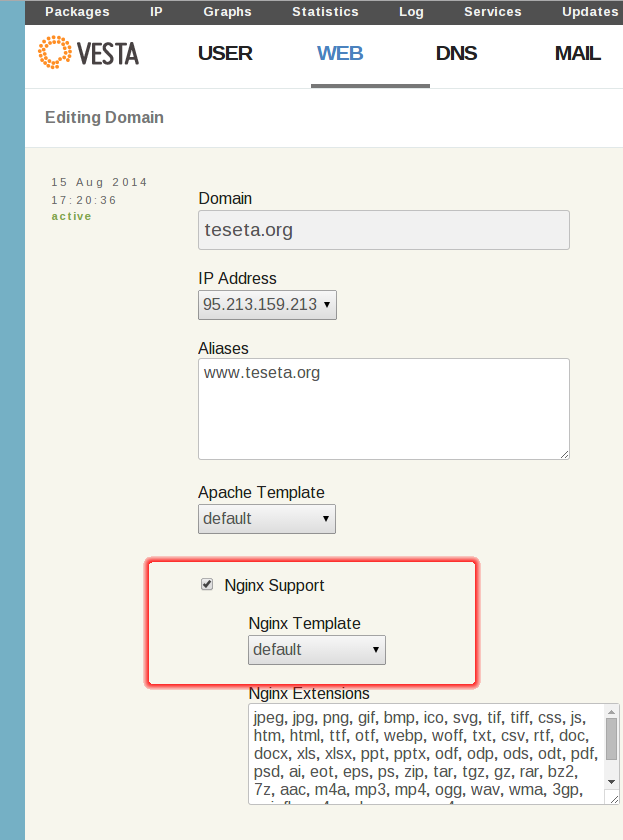
There is currently no support for the Nginx + php-fpm mode, the implementation is promised in the next release .
Despite the minimalist interface, VestaCP provides all the necessary tools for creating and managing a site: user management, creation of domains and databases. Some operations (such as, for example, setting php parameters) still need to be performed using the console. From the merits of VestaCP, we highlight the quick, user-friendly work, ease of installation and updates, and a good technical support forum.
Only one of the shortcomings can be singled out: the absence of at least a brief description of the templates from the list given for Apache, Nginx and DNS. However, this minus is not so significant: all the necessary information can be found in the official documentation , and the default templates are suitable for most cases.
Vesta CP is developing intensively; let's hope that in the near future it will become more functional and convenient.
CPanel
Developer : cPanel Inc.
First version : 1996
Latest version : 11.44.1.17 (August 2014)
Supported OS : entos 5.x, 6.x, RHEL 5.x, 6.x, CloudLinux 5.x, 6.x, FreeBSD (support has been discontinued since September 30, 2012), there is a version for Windows (not supported since February 2014 )
License : proprietary
Official site : http://cpanel.net/
From the above-mentioned panels CPanel differs complex installation procedure. Before you download from the official site and run the installation script , you will need to make preliminary preparations: disable SELinux, install Perl, set the full domain name (fqdn) in the files / etc / sysconfig / network and / etc / hosts.
During installation, all components necessary for the operation of the web server are assembled from source codes. All this for obvious reasons makes the installation process very long.
The CPanel consists of two components: the actual CPanel and WHM. WHM is a web interface for “super-admin”, with which you can access all environment settings - for example, set important parameters that affect Apache performance (max_clients, min / max spare servers and others), access to all possible php options and others. The undoubted convenience is that the settings can be changed via the web interface, and not manually edit the configuration files. However, in order for the new settings to take effect, in some cases it may be necessary to reassemble individual components.
To configure the web server, use the WHM EasyApache tool. With it, you can select a specific profile - a set of features that the server will support. If you select, for example, the Basic profile, then all requests will be processed using the standard mpm_prefork module. If you choose the MPM ITK profile, then the mpm_itk module will be used, which increases the security of the web server by dividing the processes by users:

CPanel is a control panel in the traditional sense. It is with its help that sites are managed, mail, domain names, etc. are configured. The CPanel interface is simple and straightforward even for a beginner:
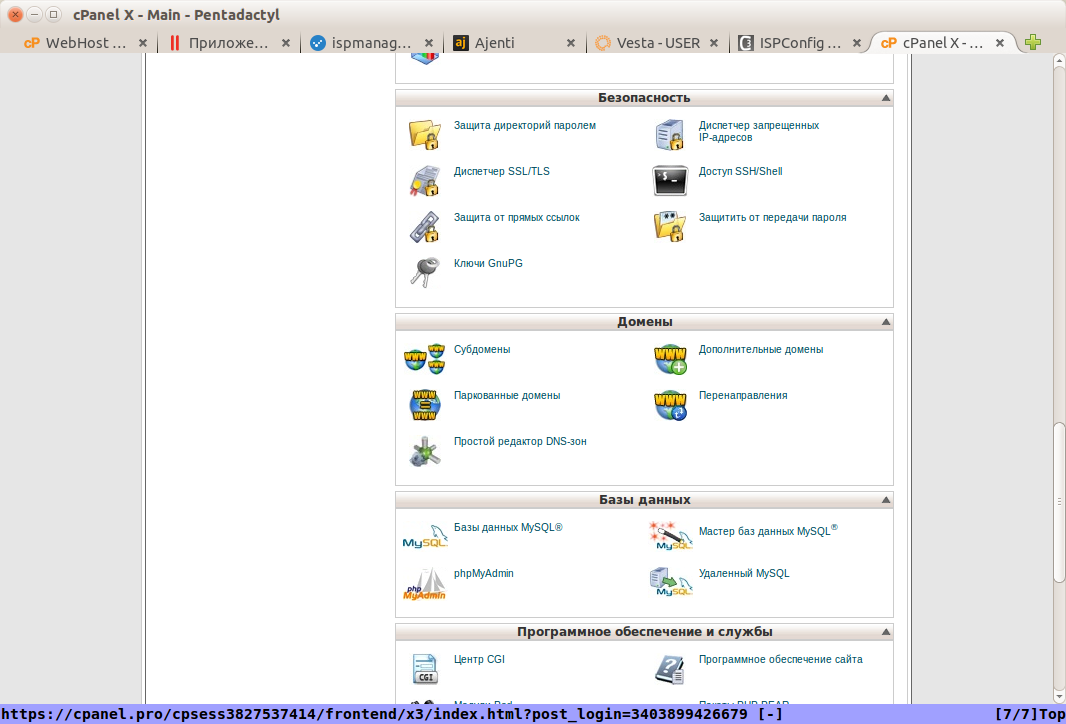
Out of the box, CPanel only supports the Apache web server. Support for other web servers is implemented using third-party plug-ins and extensions, both proprietary and free.
To use Nginx as a front end to Apache, you can, for example, resort to using the Nginx Admin plugin. To install this plugin you need to download the tar-archive, unpack it and run a specialized script. Note that in recent versions of CPanel, problems may arise with the installation of Nginx Admin. You can also use the ApacheBooster extension or the cPnginx proprietary plugin. Nginx + php-fpm support is implemented using the cpXstack plugin.
Due to the fact that CPanel is focused on working with the Apache web server, it is possible to provide ample opportunities for flexible configuration and configuration. Flexibility is provided by creating an independent environment with reassembly if necessary. Working with WHM requires a certain amount of knowledge and experience from the user, but in most cases the default settings are sufficient.
In the latest versions (starting from 11.44), the ability to centrally control other servers preloaded with WHM from the main server has been added, called the configuration cluster (Cluster Configuration, similar to the similar mode in ISPConfig - see below). Cluster job opportunities are expanding; new features are gradually added.
The undoubted advantages of CPanel include support for a wide range of software, localization into more than 20 languages, multi-level user management, and extended reselling functionality.
The reverse side of the flexibility of configuration and management is lower (compared with the above-mentioned panels) performance.
Given the cost of licensing and multi-server support, this panel can be recommended for use primarily by resellers and those who support a large number of different sites.
ISPConfig
Developer : projektfarm GmbH
First version : 2007
Latest version : 3.0.5.4 (August 2014)
Supported OS : Debian, Ubuntu, CenOS, OpenSUSE, Fedora
License : BSD
Official website : http://www.ispconfig.org/
ISPConfig , : (-, , FTP, ), . howtoforge.com (. ).
, , . , , ISPConfig; . , . : , — -, , — , .
, ISPConfig , Nginx Apache. ISPConfig , (, Nginx + php-fpm). Nginx + Apache .
- — , . OC Debian Ubuntu ISPConfig c c ISPConfig3-Debian-Installer. Apache, Nginx. Nginx + Apache .
APS — , .
ISPConfig . howtoforge.com , .
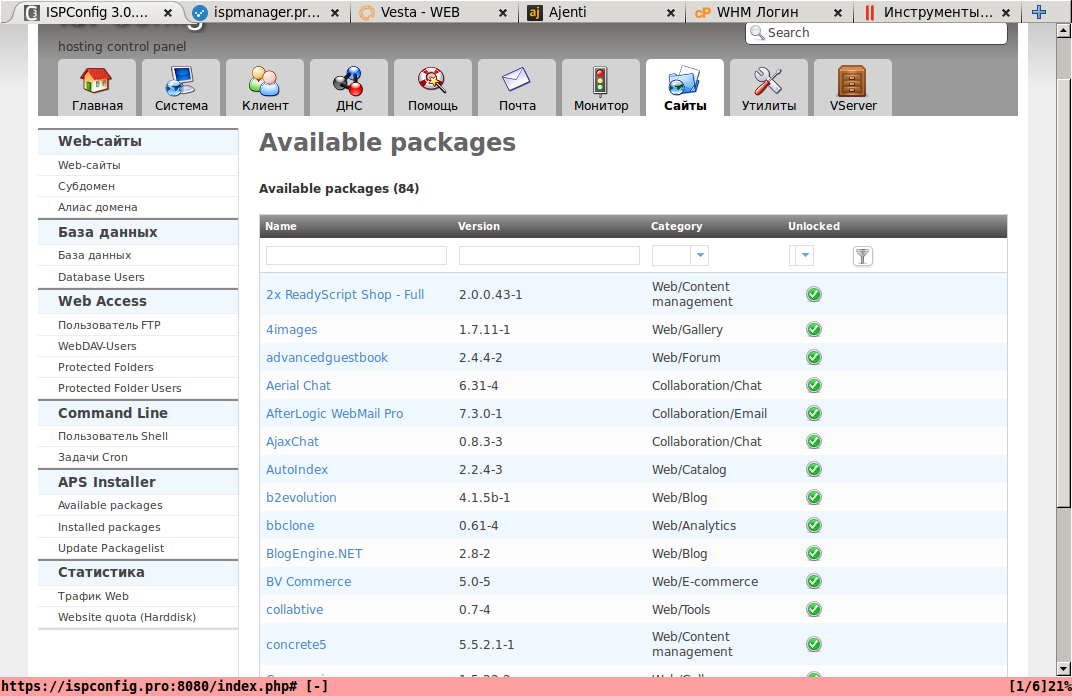
Conclusion
. ( , :
| Characteristic | ISP Manager | Plesk | WHM/CPanel | VestaCP | Ajenti-V | ISPConfig |
|---|---|---|---|---|---|---|
| Supported OS | CentOS > 6 Debian 7 FreeBSD 9 CloudLinux Windows | CentOS 5-7 Debian 6-7 Ubuntu LTS 10.04-12.04 RHEL 5-7 OpenSUSE 12.3-13.1 CloudLinux 5-6 | CentOS 5-6 RHEL 5-6 CloudLinux 5-6 | RHEL 5-6 CentOS 5-6 Debian 7 Ubuntu 12.04-14.04 | Debian Ubuntu RHEL CentOS | Debian 5-7 CentOS 5-6 Fedora 12-15 OpenSUSE 11.1-13.1 Ubuntu 8.10-14.04 |
| - | Apache Apache + Nginx Nginx + php-fpm ( 5 ) | Apache + Nginx | Apache; Apache + Nginx Nginx + php-fpm — | Apache Apache + Nginx | Nginx + php-fpm Nginx + uwsgi Nginx + Puma Nginx + Unicorn Nginx + Gunicorn Nginx + Node.js Nginx + Apache | Nginx Apache, Nginx + Apache — |
| Mysql PostgreSQL | Mysql PostgreSQL | Mysql PostgreSQL | Mysql PostgreSQL | Mysql PostgreSQL | Mysql | |
| DNS- | Bind | Bind | Bind MyDNS NSD | Bind | Bind NSD | Bind MyDNS |
| : Bind, NSD, PowerDNS | Bind | : Bind, myDNS, NSD | Bind | Bind | ||
| * phpMyAdmin | * phpMyAdmin | * phpMyAdmin | * phpMyAdmin | * ajenti-mysql | * phpMyAdmin | |
| Statistics | Awstats | Awstats Webalizer | Analog Awstats | Awstats Webalizer | , | Awstats Webalizer |
| APS | + | + | + | - | - | + |
| Security Settings | , (/ ) | Fail2ban, , spamassasin ( ) | mod_security ( ), clamav, cPHulk, , jail' vhost apache mod_ruid2 cPanel jailshell | firewall', (/ ), fail2ban, RKHunter | ||
| 5 — lite: 190 ./., pro: 570 ./. , | Web Host: 35$/ 385$/, | 20$/. (200$/) VPS. 45$/. (425$/) | GNU GPL; | AGPLv3 | BSD |
* — .
— . , , . , , , .
Readers who for one reason or another can not leave comments here are invited to our blog .
Source: https://habr.com/ru/post/239069/
All Articles